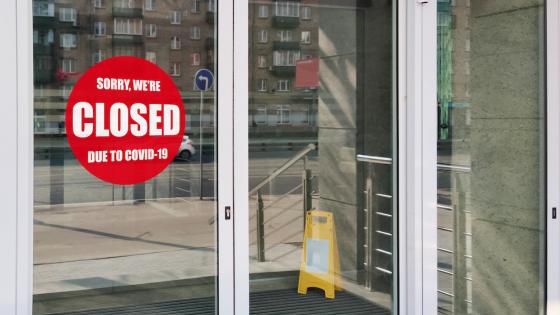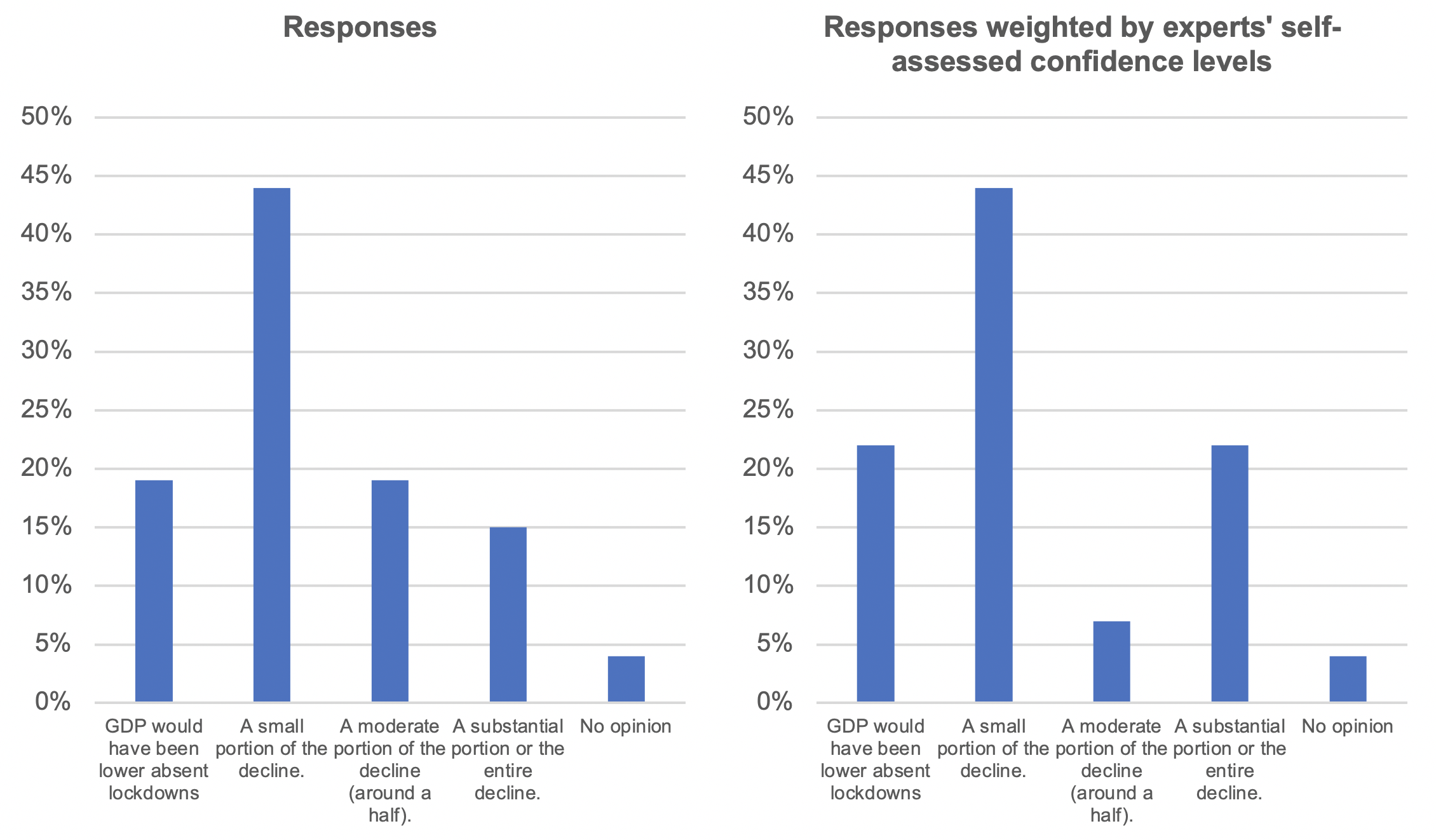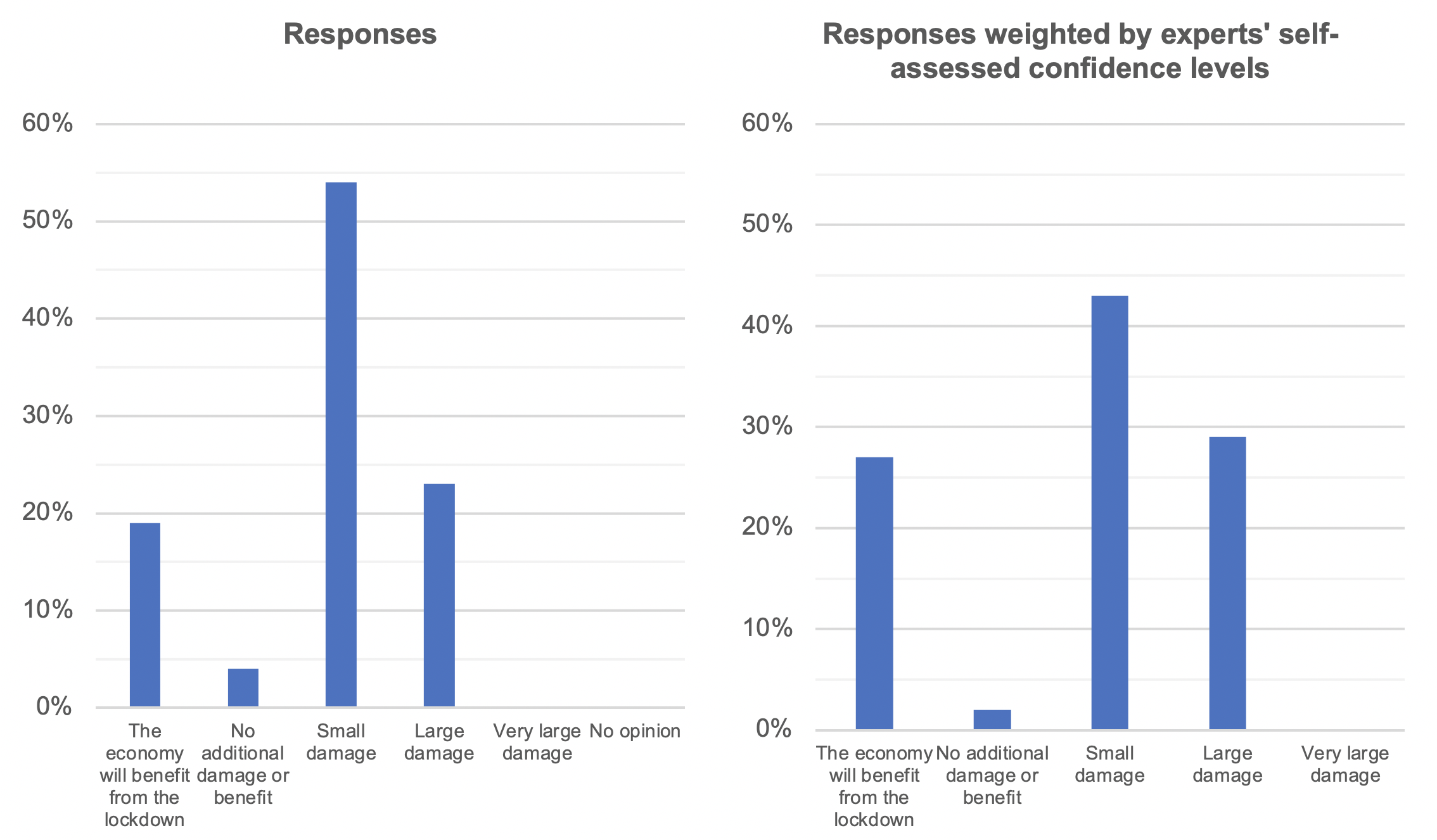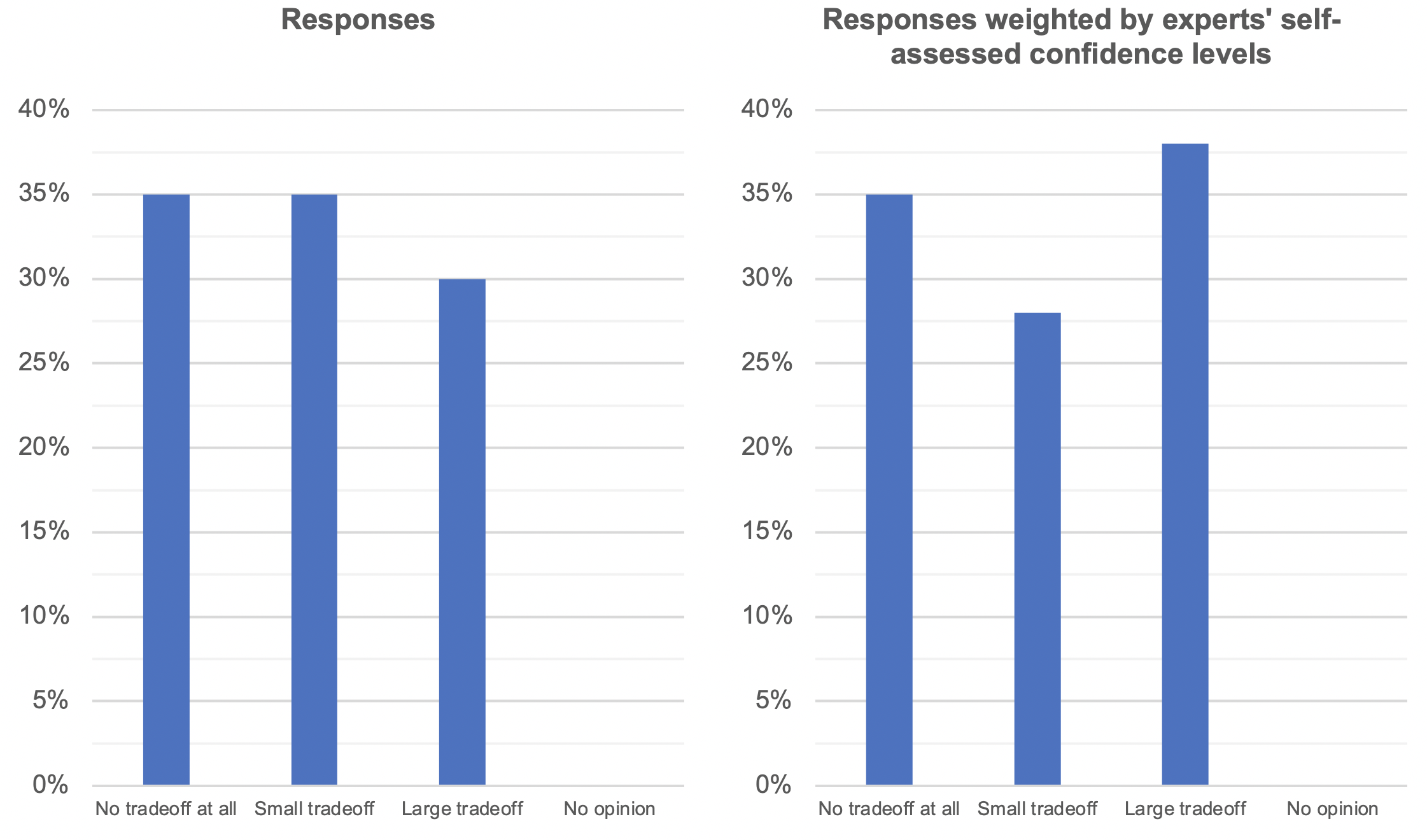In response to the Covid-19 public health crisis, the UK government has resorted to relatively broad-based lockdown measures to slow the spread of the SARS-CoV-2 virus. The UK entered its first lockdown on 23 March 2020 and lifted some restrictions through October 2020. On 5 November, the UK entered its second lockdown, currently scheduled to end on 2 December 2020. During both lockdowns, businesses including ‘non-essential’ retail outlets, hospitality venues (food and beverage establishments), accommodation, and entertainment venues were mandated to close (or restrict how goods and services are provided). The main difference between the two lockdowns is in education services, with schools, colleges and universities remaining open in the second lockdown. Additional mitigation measures came via the NHS Test and Trace scheme, comprising testing, contact tracing, voluntary location reporting and non-enforced self-isolation. The government is currently piloting a mass-testing programme using new rapid (one-hour) lateral flow Covid-19 tests (Financial Times 2020).
UK economic activity has dropped substantially since the start of the Covid-19 pandemic. For example, relative to its February 2020 level, UK monthly GDP was 25.3% lower in April 2020 and 9.1% lower in August 2020. Unemployment stood at only 4.8% in the months of July to September 2020, but this figure may understate the actual unemployment rate due to government-supported furloughs. The Royal Society’s DELVE report, Tenreyro (2020), and Vlieghe (2020) provide primers on the economic implications of Covid-19 in the UK. Chapter 2 of the IMF's October 2020 World Economic Outlook (IMF 2020) gives an international view and discusses the relative role of official measures and voluntary social distancing.
Like most other advanced economies, the UK implemented several fiscal programmes in an attempt to mitigate the economic fallout of the pandemic and the resultant lockdowns. Most prominently, the Coronavirus Job Retention Scheme (CJRS), announced on 20 March 2020 and originally expected to expire on 31 October 2020, paid furloughed employees 80% of their wages, up to a maximum of £2,500. On 5 November 2020, Chancellor Rishi Sunak announced that the scheme would be extended till 31 March 2021.
Other countries have relied on different policy mixes in response to Covid-19 and have experienced different health and economic outcomes. Sweden imposed considerably more lenient restrictions than most other countries. It fared comparably badly to the UK in terms of health outcomes, but better in terms of economic outcomes, as documented by Fernandez-Villaverde and Jones (2020). At the same time, Sweden had higher mortality rates when compared to Nordic countries such as Norway, Finland and Denmark, but similar declines in GDP.
Countries in East Asia, including China, Taiwan, and South Korea, focused early on measures such as widespread use of masks, protection of the elderly, better indoor ventilation, limited indoor contact, contact tracing, widespread testing and quarantines. This was also aided by using IT and big data (Fernandez-Villaverde and Jones 2020).
Many countries have enforced border closures. Some countries, particularly those pursuing a strategy aimed at eliminating COVID-19 within their borders, have gone further by mandating quarantines in government-run accommodation upon arrival (e.g. Australia, New Zealand, Singapore).
A notable case on widespread testing, Slovakia launched a nationwide coronavirus testing scheme in the last week of October 2020, comprising mandatory antigen swab tests for all Slovaks aged 10-65. Citizens were paid if they tested positive and needed to quarantine and received a certificate that allowed them to avoid some restrictions if they tested negative, providing an incentive to participate.
There is a fast-growing academic literature that attempts to evaluate these trade-offs. For overviews, see Giannitsarou et al. (2020) and Kaplan et al. (2020), this video explainer and the Royal Society’s DELVE report (DELVE 2020). Importantly, this literature takes into account behavioural responses to the pandemic – for example, households may cut certain types of expenditures even in the absence of lockdown measures (‘voluntary social distancing’) – and other important factors such as distributional effects. In a Guardian article, Tony Yates criticises policy research for its failure to integrate epidemiological and economic analysis in policy decisions (Yates 2020).
In this month’s CfM survey, members were asked to evaluate how the pandemic and the variety of mitigation measures affect economic activity and the extent to which they pose a trade-off between lives and livelihoods.
In the first question the panel was asked how much of the economic damage this year would have been avoided absent lockdown measures relative to an (admittedly extreme) counterfactual of no government intervention whatsoever. The second question then asked the panel to compare lockdown measures to milder measures. The responses reflect the panellists’ assessment of the economic cost of lockdowns rather than their evaluation of whether the cost was worth the public health benefit.
Question 1: How much of the decline in GDP experienced to date would have been avoided in the absence of any lockdown measures or other policy interventions (such as fiscal support)?
Twenty-seven panellists responded to this question. Well over half of the panel (63%) thought that the UK suffered little or not at all due to lockdowns and other interventions relative to a laissez faire policy. In other words, a majority of the panel believes that it is the pandemic itself, rather than the resultant lockdowns, that has caused the economic damage. In fact, nearly 20% of the panel believe that the UK economy would have suffered greater damage had there been no interventions. An additional 20% believe that the economic damage due to lockdowns has been moderate and only a small minority (15%) estimated large damages due to the lockdowns.
Costas Milas (University of Liverpool) expresses the majority view: “In the very short run, GDP would have dropped by less. In the medium run, however, an ‘unchecked’ virus would have triggered a much larger number of infections and a huge loss in terms of lives, in which case, the economy would have suffered on an unprecedented scale”. Benjamin Moll (London School of Economics) writes that his “rough best guess” is that “without lockdown measures and fiscal support the recession would have been around 50-75% as deep as the one we actually experienced.” He arrives at this estimate based on Kaplan et al. (2020), DELVE (2020), and Tenreyro (2020). Several respondents pointed out that voluntary social distancing – dramatically increased with an uncontrolled spread of the virus – will have caused substantial economic harm even absent lockdowns. Chryssi Giannitsarou (University of Cambridge) points to the comparison of Sweden and Denmark in Sheridan et al. (2020), who note that “social distancing laws cause only small losses of economic activity during the COVID-19 pandemic in Scandinavia”. She further added that “the indirect impact due to potentially overwhelming the health sector is … potentially substantial”. Similarly, Ricardo Reis (London School of Economics) writes that “by the time the UK government imposed a lockdown, people had already been voluntarily withdrawing from contact with each other. The people led, the government followed. There would have been a large tumble in GDP even without the lockdown, as the experience in Sweden suggests.”
Regardless of the lockdowns, additional economic damage would have resulted because of the slowdown in the global economy. Dawn Holland (National Institute of Economic and Social Research) estimates that “close to half of the decline in output can be attributed to spillovers from the rest of the world”. Several respondents pointed to the harm brought by the government’s lagged response to the pandemic and poor communication of the lockdown, rather than the lockdowns themselves. Abi Adams-Prassl (University of Oxford) argues that “the poor functioning of the UK contact tracing infrastructure and bad health outcomes continue to restrain spending”. Morten Ravn (University College London) believes the economy would have performed worse absent lockdowns and states that “the policy communication at the start of the pandemic was terrible … a faster, better communicated, and more decisive lockdown could have meant significantly smaller costs to health and the economy both in the short run and in the longer run”.
Other respondents who viewed the lockdowns as having a positive impact on the UK’s economic performance point to the massive economic damage of unchecked spread of the virus. Thorsten Beck (Cass Business School) presented the view that “an unlimited spread in the pandemic would have led to serious disruption in basic economic services (e.g. transportation) due to labour shortages, with wider negative repercussions for the economy. Not having any lockdowns and – additionally – not any economic policy measures would have exacerbated the economic outlook further.” Francesca Monti (Kings College London) points to the evidence of Correia et al. (2020), who “[used] regional data from the 1918 Flu Pandemic, [and found] that social distancing measures did not seem to worsen the downturn: to the contrary, evidence on manufacturing activity and bank assets suggests that the economy performed better after the pandemic in areas with more aggressive public health policies. The reason is that, even if the restrictions depress economic activity when they are in place, such measures can mitigate the most severe and persistent economic disruptions, by reducing the severity of the pandemic.” She also points to theoretical models supporting this evidence, such as Bodenstein et al. (2020). Finally, several respondents believe that the fiscal support measures had a strong positive effect on the UK’s economic performance.
Angus Armstrong (National Institute of Economic and Social Research) opined that “without policy interventions (especially the CJRS), unemployment would have been much higher judging by the 9.6 million furloughed jobs since the crisis, meaning much weaker income and spending possibly leading to a secondary financial problem. The Treasury deserve real credit for acting fast and on scale once the emergency was recognized.” Dawn Holland concurs, estimating that “fiscal support measures have offset at least 2 percentage points of the potential decline in economic activity”.
Benjamin Moll summarises that it is the “cardinal sin of pandemic economics” to hold the mistaken view that “absence of lockdown measures, the economy would have experienced only a very mild recession or no recession at all”.
Several panel members took the opposing view that far less economic damage would have been sustained absent lockdown measures. As Michael Wickens (Cardiff Business School and University of York) puts it: “The deserted high streets speak for themselves.” Patrick Minford (Cardiff Business School) points to the case of Sweden to support this view: “Had the government followed Swedish-style policies of social advice, there would have been a fall as people took social distancing measures. But it would have been much reduced, as indeed was the Swedish fall.” However, a number of respondents pointed to Sweden as a case that supports the notion that that the pandemic, rather than lockdowns, was the main cause of the recession. Finally, Roger Farmer (University of Warwick) notes that the pandemic mainly affected the elderly and that “at the risk of being misinterpreted, the elderly do not contribute substantially to GDP”.
Question 2: How much will the new lockdown measures introduced on Thursday November 5 hurt UK economic activity this year relative to a counterfactual with the milder measures adopted over the summer?
Twenty-six members of the panel responded to this question. Consistent with the response to the first question, a majority of the panel viewed the economic damage due to a lockdown to be small (compared with the previous milder social distancing measures). Regarding the current lockdown, a larger majority (74%) expressed this opinion and once again 20% assess the current lockdown as benefiting the UK economy. These ‘lockdown optimists’ were the group that expressed the greatest confidence in their answer. Slightly more than 20% of the panel expressed the minority view that the lockdown is causing large damage to the economy. Not a single panel member assessed the damages as being ‘very large’.
Panellists’ views on the second question were very much correlated with their responses to the first. However, several respondents drew a distinction between the first and second lockdown. Panel members outlined reasons why the current lockdown would be less damaging than the first. Natalie Chen (University of Warwick) points out that “the lockdown is less restrictive than in March and is limited in time, so the economy should slow down but not too much”. In addition, households and businesses have now adapted to consumption under the pandemic. Patrick Minford views the current lockdown as less damaging because “it seems that most of the economy has now found ways of working around lockdown. There will be disruption of hospitality and travel which were beginning to recover; the extent is hard to gauge but given that the lockdown ends by December, it should be limited.” Thorsten Beck adds that “the negative impact of this lockdown … will be less than the impact from the first lockdown, as people have adjusted consumption habits and there will most likely be less precautionary savings”.
Other panel members held the opposite view, that the current lockdown would be more damaging that the first. Ricardo Reis writes that “previous stocks of savings have been depleted. Uncertainty is high because the government's credibility is low so, according to the media, many do not believe the lockdown will only last until early December. And, again from media reports, it seems harder to get people to comply, as they have adjusted their risk tolerance, in which case the government restrictions will bind behaviour, unlike back in March.” Federica Romei (University of Oxford) suggests that adaptation to the pandemic implies that the second lockdown will sustain larger costs: “There is much less uncertainty: we know that the Covid-19 virus hits disproportionally more the older adults than the young. For this reason, I would think that a considerable chunk of the population would keep consuming non-tradable goods in the absence of a lockdown.” Roger Farmer alludes to the distributional consequences of the lockdown: “What is clear is that economic activity will be lower as a consequence and the incidence will fall disproportionately on the poor.”
The third question asked panellists to assess the trade-off between lives and livelihoods over a longer (two-year) horizon and to also take into account a broader set of policy tools than those implemented in the UK. In this regard, the panel was asked:
Question 3: Using not only the policy tools that have been part of the UK policy mix thus far but also policy tools implemented in other countries, to what extent does the government face a trade-off between saving lives and preserving livelihoods?
Thirty-four panel members responded to this question. The panel was equally split between the three options with a third assessing no trade-off between the economic and public health policy objectives, a third evaluating the trade-off as small, and a third viewing the trade-off as large. On this question, the latter was the group most confident in its response.
Panellists arguing that there is a large trade-off remind readers that economic slowdowns could also lead to loss of life. Roger Farmer opined that: “For better or worse, there is a difficult trade-off here. The lives saved are predominantly the elderly and the sick. The livelihoods preserved are predominantly the poor and the young. I would add that lockdowns do not just affect livelihoods, they contribute to deaths through despair, suicide, and failure to access medical care for otherwise treatable conditions.” In a similar vein, David Miles (Imperial College London) expressed that “it may well be a trade-off between lives lost to COVID now and lives lost (and others blighted) for many years to come. To go for total suppression now until a vaccine is widely available so as to minimise lives lost now due to COVID would plausibly wreak widespread costs to health, life expectancy and livelihoods for years to come.”
At the opposite extreme, more than a third of panel members suggest there is no trade-off at all. Interestingly, this number was larger than the around 20% of respondents who answered that lockdown measures benefit the UK economy in questions 1 and 2. Angus Armstrong writes that “citizens have to feel safe to interact for the economy to recover. This means keeping R at or below 1 on an ongoing basis. Lockdowns are necessary because other measures to limit interaction have failed (like test, track and isolate).” Chryssi Giannitsarou adds: “Well designed policies can both preserve livelihoods and save lives. Suppression measures not only save lives, but also ensure that the rest of the population has better health and therefore is more productive and eventually economically active.”
A few panel members note that better public policies could have made the trade-off less acute or could have even meant that health and economic outcomes go hand-in-hand. Patrick Minford asserted: “Had the government focused on preventing infection among vulnerable groups, including in care homes and hospitals, it could have saved many lives while causing less disruption to the economy.” Supporting this is Costas Milas’s recent research, which “[showed] that the greater the strength of government interventions at an early stage, the more effective these are in slowing down or reversing the growth rate of COVID-19 deaths”. Michael Wickens added that “many of the current lockdown measures - especially those involved in outdoors activities - make little sense even in terms of lives saved”.
Also calling for better public policies, Benjamin Moll opines that “(a) there likely is a trade-off between ‘saving lives’ and ‘preserving livelihoods’ if the primary policy tool being used are blunt lockdown measures … without an ‘endgame plan’; but (b) that, at the same time, there isn’t necessarily a trade-off once other policy tools are included in the policy mix and, in fact, lives and livelihoods can go hand in hand.” He quotes a recent paper by Berger et al (2020) that highlighted the sub-optimality of ‘blunt’ lockdowns directly: “Theories of economic-activity vs. mortality trade-offs with only a lock-down policy available to the policy-maker are … necessarily discussions of second-best policies.” Moll points to the cross-country evidence as supporting the view “that, with a broader policy mix, lives and livelihoods can go hand in hand” and points to a “New-Zealand-style disease elimination strategy” as an example because it could allow a country to discontinue lockdown measures “before reaching population immunity”.
Finally, Charles Bean (London School of Economics) argues that the trade-off depends on how close we are to a vaccine and how effective the vaccine and its delivery are. He explained that if an effective vaccine is found, “the nature of the trade-off is clear, … [though] considerable”. If the search is unsuccessful, however, “the trade-offs are more subtle”, and require one to “[set] the economic costs from periodic health restrictions against the benefits from preventing hospitals being overwhelmed”. After highlighting how “effective test, track and isolate [systems]” served as the key to alleviating the trade-off in Asia, he cites the clear positive correlation between Covid-19 deaths/million and GDP loss during the first wave as evidence that “data [is] not strongly suggestive of a trade-off between lives and livelihoods”.
Authors’ note: The authors acknowledge Jason Jia for his able research and editorial assistance.
References
Andersen, A L, E T Hansen, N Johannesen and A Sheridan (2020), “Consumer Responses to the COVID-19 Crisis: Evidence from Bank Account Transaction Data”.
Berger, D, K Herkenhoff, C Huang and S Mongey (2020), “Reopening in an SEIR model with Testing and Targeted Quarantine”.
Bodenstein, M, G Corsetti and L Guerrieri (2020), “Social Distancing and Supply Disruptions in a Pandemic”.
Financial Times (2020), “Liverpool to be first UK city to hold trial of mass testing for Covid-19”, 2 November.
Correia, S, S Luck, and E Verner (2020), “Pandemics Depress the Economy, Public Health Interventions Do Not: Evidence from the 1918 Flu”.
DELVE (2020), Economic Aspects of the COVID-19 Crisis in the UK, Royal Society Data Evaluation and Learning for Viral Epidemics (DELVE) Initiative.
Dergiades, T, C Milas, E Mossialos and E Mossialos (2020), “Effectiveness of Government Policies in Response to the COVID-19 Outbreak”.
Economics Observatory (2020), “Covid-19: Economics meets epidemiology”.
Fernandez-Villaverde, J and C I Jones (2020), “Macroeconomic Outcomes and COVID-19: A Progress Report”.
Giannitsarou, C, S Kissler and F Toxvaerd (2020), “Waning Immuity and the Second Wage: Some Projections for Sars-CoV-2”, forthcoming in the American Economic Journal, Insights.
IIMF (2020), World Economic Outlook, October 2020: A Long and Difficult Ascent.
Kaplan, G, B Moll and G L. Violante (2020), “The Great Lockdown and the Big Stimulus: Tracing the Pandemic Possibility Frontier for the US”, Working Paper.
Tenreyro, S (2020), “Covid-19 and the economy: what are the lessons so far?”, speech at the Bank of England.
Vlieghe, G (2020), “Assessing the Health of the Economy”, speech at the Bank of England.
Yates, T (2020), “Without joined-up thinking about Covid and the economy, Britain is just guessing”, The Guardian, 30 September.






